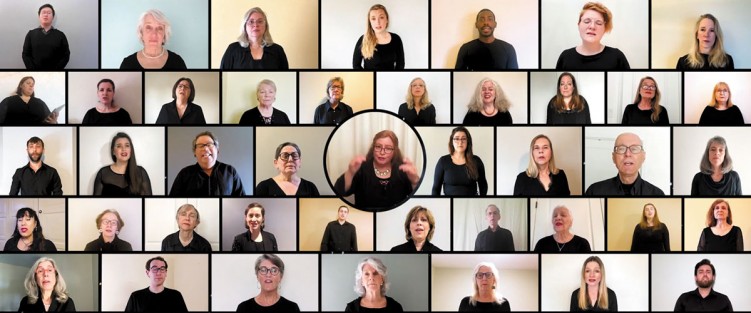 Lockdowns! Vaccines! Homemade focaccia! Yes, we are still talking about the pandemic. The media cacophony rises like the tides: job losses, school closures, suspension of hobbies, failing businesses, whole sectors with the rug swept out from under them, including live performance and gathering to make music.
Lockdowns! Vaccines! Homemade focaccia! Yes, we are still talking about the pandemic. The media cacophony rises like the tides: job losses, school closures, suspension of hobbies, failing businesses, whole sectors with the rug swept out from under them, including live performance and gathering to make music.
Happily, with survival depending on reevaluation, creativity and adaptation, we are witnessing an unexpected resurgence among musical ensembles finding ways to get together, even at a time when gathering in person is met with finger-wagging (not from the conductors) and hefty fines.
Regular readers know that May is usually the month when The WholeNote publishes its Canary Pages Choral Directory, but that in May 2020 the period for joining the directory was extended from May right through September, with choral profiles being posted to the website as soon as received. Well, it’s May again, and while uncertainty still prevails for many choirs, a heartening number have already signed up. So I reached out to several of these “early adopters” who have already submitted profiles for this year’s Canary Pages, to try to get a feel for how they weathered the past year and how, if at all, their plans for the coming season are further along than at this time last year.
Many expressed frustration, mostly due to the shift of being predominantly online. Most are in agreement, however, that the show, and the opportunity to sing together, must go on. And although more muted than usual, choral directors and choristers are still working together behind the scenes to keep the music in the air. Figuratively speaking, of course.
Keeping a Sense of Community
A choir is not just a performing ensemble, it is a community, synonymous with togetherness: the weekly rehearsals, members shoulder to shoulder or facing one another, breathing in unison, voices harmoniously creating magic ... all in the current context a condemnable germ-y activity.
When the first lockdown was announced, choristers were faced with a tough decision: interrupt the choral season or sing on whilst learning to navigate unfamiliar territory. Like true leaders, many choral directors forged on and took their choirs online. It wasn’t perfect; memberships decreased and singers were initially skeptical about singing virtually, some choosing to pull back altogether until in-person rehearsals resume.
I asked the directors I reached out to how they had kept their members engaged in a time that saw a decline in motivation. The general consensus was that the pandemic, although unwelcome, prompted them to be even more creative in their approach in order not to stagnate.
Pauline McKenzie is the advertising representative of the Jubilate Singers, a community choir of between 25 and 50 singers, conducted by Isabel Bernaus. She mentioned integrating social activities into their rehearsal time. An example she gave was holding “pot lucks”, where snacks or full meals were eaten “companionably with others”. She also detailed breaking out into “rooms” to allow for small group interactions on assigned topics, [such as] “show-and-tell” where members would share a personal item with their groups.
Peg McCracken, business manager of the Peterborough Singers, an auditioned choir of over 100 singers under the direction of Sydney Birrell, acknowledged that “there was a definite decrease in attendance at [their] virtual events; but for those who wanted to stay connected [they] created things like a singer’s buy-and-sell page and have intentionally been very active on social media and YouTube with trivia contests and information sessions.”
Les voix du coeur is a vocal ensemble of over 40 amateur singers, dedicated to showcasing French popular songs from Canada and Europe; they pride themselves on being a prominent fixture in Toronto’s French-speaking cultural community. Catherine Chereu-Sharp, vice-president and secretary of the board of directors, described a similar approach to McCracken’s, “offering workshops on music theory, breathing, acting techniques and regular virtual meetings to keep everyone informed and stay in touch.”
Zoom Adventures: the Good, the Bad and the Pantless
From business meetings, to parties, to dates, Zoom became the leading online platform for video conferences during the pandemic, so it is no surprise that Zoom was unanimous as the chosen method of practice for the choirs I contacted. Unsurprisingly, it comes with its challenges, some recognized benefits and many humorous anecdotes. One thing is for sure, when this is all over, there will not be a shortage of awkward Zoom tales.
When asked about the most challenging aspect of an online environment, Jenny Crober, artistic director of the VOCA Chorus of Toronto, an auditioned, inclusive ensemble, comprised of 50 to 100 singers, detailed it perfectly. “The first thing that comes to mind is the heartache of not being able to enjoy the simple, irreplaceable joy of singing together with each other […] and missing the simple, incredibly powerful physical connections with each other … like a hug, and monthly pub night at a real (not virtual) pub.” Additionally, she mentions “dealing with the occasional vagaries of technology, including Zoom, where calls of ‘You’re still muted!’, ‘My Internet just died!’, and ‘Could you put me back into my Breakout Room please?’ were aplenty. Crober spoke highly of Zoom’s “Breakout Rooms” feature as a method used to organize the choir into smaller, more manageable sectionals, led by herself, the accompanist, and the professional section leads accordingly.
Each VOCA session begins together in the main room, where a variety of warm-ups are conducted and one of their six professional section leads teaches the rest of the choir about specific musicianship skills. (And on Monday nights yoga sessions with their accompanist, Elizabeth Acker.) They then separate into pre-assigned breakout rooms, “absolutely invaluable each week for fine-tuning and providing detailed coaching sessions.”
Crober finds a silver lining to their new online practice, sharing that “many choristers, who had initially doubted the effectiveness of Zoom at the beginning of the season, began to really enjoy and look forward to [their] Monday night sessions” – partly for the coaching, but also very much for the camaraderie. She has no shortage of humorous anecdotes from choristers: loud pets, swearing neighbours and interminable construction. All are entertaining after the fact, but she emphasizes that “all manner of poorly timed incidents made [our] virtual choir recording experiences unforgettable!”
Virtual fatigue
Running a smooth online rehearsal requires technological savvy, and awkwardness is an unavoidable aspect of the past year’s learning curve. Was that a delay in the soprano section, or did the Internet just cut out for a second? Albert Wong, musical director of the Harbourfront Chorus, a non-auditioned community choir with under 25 singers, preaches to the choir (in every sense of that phrase) about recognizing “Zoom fatigue.” Being a smaller, more intimate group, as Wong points out, “the community aspect of [the] choir is very strong.” He, therefore, was adamant on ensuring they had “some sort of continuity” as the isolation has dragged on, with two Zoom sessions every month. He is quick to acknowledge that they were not for everyone, noting a decrease in attendance during online sessions compared to the normal number with in-person rehearsals. On the plus side, he says, a benefit of Zoom has been the ability to reconnect with members of the choir who had moved to different provinces, and have now been able to rejoin the group.
The Peterborough Singers, Peg McCracken says, had to take a slightly different approach to maintain the Singers during the pandemic. Zoom rehearsals “proved to be quite frustrating for a certain portion of the choir that was unable to access reliable WiFi.” So right from the onset they “formed a recovery task force that set up the guidelines and safety objectives for small in-person rehearsals. Just over half of [their] members were able to attend a series of weekly in-person rehearsals lasting one hour each. Strict protocols were set up in order to ensure everyone’s safety. These sessions concluded at Christmas as the COVID situation worsened.”
Moving Forward
While some choirs simply decided against putting on concerts entirely until given permission to perform live again, others dug deep into the virtual world and produced online concerts and other productions online, learning along the way. Tedious and extensive as the process might have been, it’s a true testament to the tenacity of these choral communities, and the strength of their support for one another, that they were able to accomplish as much as they did. We’ll dig deeper into progress being made in regard to this aspect of things as 2021/22 takes clearer shape.
It was certainly very unbecoming of March 2020 to have all of us strap ourselves into a rickety, year-long roller coaster ride, including loops we really did not want to go through. But, a year later, nauseated, and with our knuckles turned white, we have at least figured out the mechanics. Safe to say, however the coming year unfolds, we will all be better equipped to enjoy the ride.
Menaka Swaminathan is a chorister and soloist on hiatus, eager to get back to a singing groove. She is currently a writer and student of Vision Therapy, based in Toronto.



